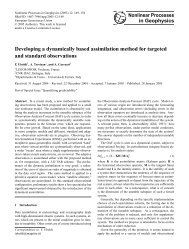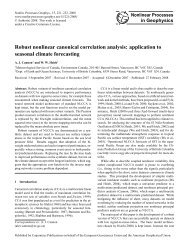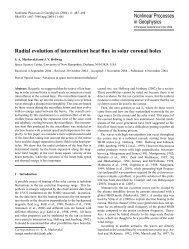Long solitary internal waves in stable stratifications
Long solitary internal waves in stable stratifications
Long solitary internal waves in stable stratifications
Create successful ePaper yourself
Turn your PDF publications into a flip-book with our unique Google optimized e-Paper software.
W. B. Zimmerman and J. M. Rees: <strong>Long</strong> <strong>solitary</strong> <strong>waves</strong> 171<br />
<strong>in</strong>homogeneous systems that arise are<br />
[ ] [<br />
]<br />
θ<br />
(1)<br />
−θ<br />
M k<br />
φ (1) =<br />
φ y − λ 1 (y − ν) φ<br />
[ ] [<br />
]<br />
θ<br />
(2)<br />
θ<br />
M k<br />
φ (2) =<br />
φ y − λ 2 (y − ν) φ<br />
[ ] [<br />
]<br />
θ<br />
(3) [<br />
θ y φ − θφ y<br />
M 2k<br />
φ (3) =<br />
φφ yy − φy]<br />
2 − λ 3 (y − ν) φ<br />
y<br />
[ ] [<br />
]<br />
θ<br />
(4)<br />
0<br />
M 2k<br />
φ (4) =<br />
−φφ y − λ 4 (y − ν) φ<br />
[ ] [<br />
]<br />
θ<br />
(5)<br />
0<br />
M 2k<br />
φ (5) =<br />
φφ y − λ 5 (y − ν) φ<br />
(28)<br />
the ϕ (i) are<br />
L k<br />
[ϕ (1)] = Riθ + φ y (y − ν) − λ 1 (y − ν) 2 φ<br />
L k<br />
[ϕ (2)] = φ (y − ν) − λ 2 (y − ν) 2 φ<br />
[<br />
L 2k ϕ (3)] = −Ri ( )<br />
θ y φ − θφ y<br />
+ (y − ν)<br />
[ ]<br />
φφ yy − φy<br />
2 − λ 3 (y − ν) 2 φ<br />
y<br />
L 2k<br />
[ϕ (4)] = φφ y (y − ν) − λ 4 (y − ν) 2 φ<br />
L 2k<br />
[ϕ (5)] = −φφ y (y − ν) − λ 5 (y − ν) 2 φ (31)<br />
Application of the Fredholm alternative theorem yields the<br />
follow<strong>in</strong>g expressions for the λ i :<br />
∫ 1<br />
(<br />
Riθ 2 + φ y θ ) (y − ν) dy<br />
The l<strong>in</strong>ear operator M is identified by rewrit<strong>in</strong>g Eq. (19) as a<br />
homogeneous boundary value problem. The Fredholm alternative<br />
theorem provides a criterion for the existence of<br />
solutions of the above five <strong>in</strong>homogeneous boundary value<br />
problems–the <strong>in</strong>ner product of the forc<strong>in</strong>g vector with any<br />
eigenfunctions of the adjo<strong>in</strong>t operator M ∗ must vanish. Due<br />
to the extended separation of variables (22) and (25), the<br />
Fredholm alternative theorem holds <strong>in</strong>dependently for all<br />
D (i) s<strong>in</strong>ce a l<strong>in</strong>ear system (28) results for each undeterm<strong>in</strong>ed<br />
function D (i) that is solvable only if the identifications (27)<br />
are made. Thus s<strong>in</strong>ce the quadratic order operators are all<br />
M 2k , the criteria is that the <strong>in</strong>homogeneous forc<strong>in</strong>g vector<br />
must be orthogonal <strong>in</strong> these cases to the eigenfunctions of<br />
this operator M 2k , not M k . This solvability condition only<br />
obta<strong>in</strong>s because the extended separation of variables (22)<br />
and (25) results <strong>in</strong> a hierarch<strong>in</strong>g of l<strong>in</strong>ear systems for which<br />
the superposition pr<strong>in</strong>ciple holds. This dist<strong>in</strong>ction must be<br />
made s<strong>in</strong>ce there is no general solvability condition for fully<br />
nonl<strong>in</strong>ear systems, for <strong>in</strong>stance Eq. (14). The purpose of<br />
our analysis is to use perturbation methods and a separation<br />
scheme so that the component l<strong>in</strong>ear systems (28) are solvable.<br />
In order to save on computations, it is desirable to work<br />
with a self-adjo<strong>in</strong>t system. Follow<strong>in</strong>g Weidman and Velarde<br />
(1992), it is observed that the boundary value problems for<br />
the modified vertical eigenfunctions<br />
φ(i)<br />
ϕ (i) =<br />
y − ν<br />
(29)<br />
are self-adjo<strong>in</strong>t. Namely, the l<strong>in</strong>ear operator, on elim<strong>in</strong>at<strong>in</strong>g<br />
the temperatures θ (i) is<br />
L k [ϕ] =<br />
[(y − ν) 2 ϕ y<br />
]y + (<br />
Ri − k 2 (y − ν) 2) ϕ (30)<br />
The five <strong>in</strong>homogeneous boundary value problems now for<br />
λ 1 =<br />
λ 2 =<br />
0<br />
∫ 1<br />
0<br />
∫ 1<br />
0<br />
∫ 1<br />
0<br />
λ 3 = − ⎝Ri<br />
λ 4 =<br />
∫ 1<br />
φ 2 (y − ν) dy<br />
φ 2 dy<br />
φ 2 (y − ν) dy<br />
⎛<br />
0<br />
∫ 1<br />
0<br />
∫ 1<br />
0<br />
+<br />
θ (2k) ( θ y φ − θφ y<br />
)<br />
dy<br />
∫ 1<br />
0<br />
⎛<br />
· ⎝<br />
∫ 1<br />
0<br />
θ (2k) φφ y (y − ν) dy<br />
θ(2k)φ (y − ν) 2 dy<br />
⎞<br />
[ ]<br />
θ (2k) (y − ν) φφ yy − φy<br />
2 dy ⎠<br />
y<br />
⎞<br />
θ (2k) φ (y − ν) 2 dy⎠<br />
λ 5 = −λ 4 (32)<br />
Figure 5 shows an example calculation of the phase velocity<br />
ν (k) for Ri = 10, and the eigenfunction ϕ (y) with<br />
k = 0.05. The two po<strong>in</strong>t boundary value problem (30) was<br />
solved numerically with homogeneous boundary conditions.<br />
As the boundary value problem is derived from an <strong>in</strong>viscid<br />
model, it does not suffer from the well known parasitic<br />
growth problem, thus standard numerical <strong>in</strong>tegration techniques<br />
(e.g. Runge-Kutta) are sufficient to ma<strong>in</strong>ta<strong>in</strong> accuracy.<br />
The <strong>in</strong>viscid modes were solved for previously by Davey and<br />
Reid (1977) us<strong>in</strong>g a long wave limit. The extension to f<strong>in</strong>ite<br />
wavenumber is straightforward here. The only particular difficulty,<br />
somewhat apparent from Fig. 5, is that the approach<br />
of the eigenfunction to y = 1 becomes steep as Ri → 1/4,<br />
−1






